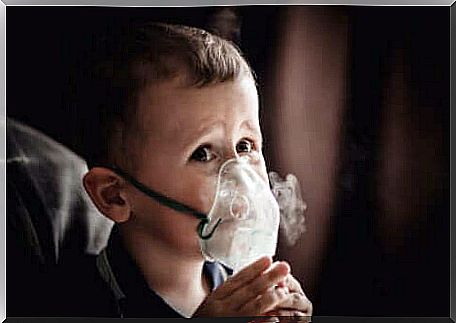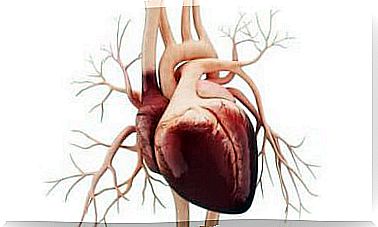Pulmonary Heart: Causes, Symptoms And Risks

Cor pulmonale is defined as damage to the right side of the heart as a result of severe lung disease. Symptoms range from fluid retention to progressive breathing difficulty.
Treatment options for cor pulmonale are quite limited, as the underlying disease must first be resolved. We talk about it in detail in the following lines.
What are the symptoms?
They depend on the underlying disease and associated heart injury, as well as the severity of the disorder. It is quite common to experience progressive breathing difficulties (dyspnea).
The latter may initially occur when engaging in moderate-intensity physical activity, such as walking long distances or climbing stairs. In severe cases it can even occur at rest.
The damage to the heart is accompanied by swelling due to the accumulation of fluids (edema) in various parts of the body, such as the lower limbs. Swelling of the jugular veins and enlargement of the liver (hepatomegaly) are also common symptoms.
Main causes of cor pulmonale
Cor pulmonale is caused by a wide variety of conditions that impair the proper functioning of the lungs. This includes alteration of the vascular system and bronchopulmonary tissue.

Chronic Obstructive Pulmonary Disease (COPD)
As the name suggests, this pathology causes progressive lung damage produced by continuous inflammatory reactions. According to the World Health Organization (WHO), it is among the leading causes of mortality in the world.
The main risk factors are prolonged smoking and exposure to biomass combustion, as occurs in wood firing.
Symptoms of COPD are: dyspnoea, fat cough and predisposition to respiratory infections. Lung damage results in reduced blood oxygenation, which can result in permanent oxygen therapy for the patient.
There are several comorbidities associated with this disorder, and cor pulmonale is one of them. In the latter case, the prognosis is complicated, since the treatment of both pathologies is complex.
Cystic fibrosis
It is a disease with a strong genetic component which, in addition to affecting various organs, particularly attacks the lungs. It is characterized by the alteration of secretions, in particular of the mucus produced naturally in the respiratory tract.
This increases the risk of fatal respiratory infections, such as those caused by the bacterium Pseudomonas aeruginosa. The damage is usually quite noticeable, so much so that in most cases cystic fibrosis is diagnosed within the first months or years of life.
Pulmonary hypertension frequently occurs as the disease progresses, resulting in heart failure. As some studies indicate, infant mortality often increases significantly after the diagnosis of cor pulmonale.
Scleroderma
This term is used to describe a set of disorders that cause fibrosis and the progressive failure of almost all organs. Fibrosis is a repair process that generates tissues without a specific function.
Dermatological reactions are quite frequent, but among the internal organs it is the lungs that are most affected. In this sense, it causes diffuse interstitial lung disease which, as in the previous case, also leads to pulmonary hypertension.
From an epidemiological point of view, scleroderma generally affects women between the ages of 30 and 50. Although there is no definitive cure, the treatment is aimed at relieving symptoms and reducing associated inflammatory phenomena.
How is cor pulmonale diagnosed?
For diagnosis, doctors employ a combination of clinical and paraclinical tests. From an anatomical point of view, cardiac lesions associated with the cor pulmonale impact the cavity called the right ventricle and are known as hypertrophy and dilation.
The first determines an increase in the thickness of the walls of the cavity itself, while the second refers to an increase in the size of the ventricle.
Both are detectable with a simple chest X-ray or an EKG, but must be confirmed by an ecosonogram or MRI.
Early pulmonary hypertension is confirmed with right cardiac catheterization. This technique involves inserting a tube into a vein in the groin area, neck or arm. It is then advanced until it reaches the right side of the heart to measure its pressure.
Treatments available

In most cases, the therapy is rather complicated; and this is due to the high mortality associated with the disorder. Furthermore, since cor pulmonale is a secondary disease, the most effective approach is to eliminate or reduce the changes that cause heart damage. This may also be impossible in severe cases, unless a lung transplant is performed.
Depending on the patient’s clinical picture, drugs can be administered to relieve symptoms related to water retention. Diuretic drugs in this sense are useful, although they involve contraindications that the doctor must take into consideration.
Although it is possible to treat pulmonary hypertension with some drugs (such as pulmonary vasodilators), they are not as effective for diseases that complicate the cor pulmonale.
Preventing cor pulmonale
Preventive measures consist in avoiding the risk factors of lung diseases. Among the most effective habits in this sense we find the following:
- Progressively eliminate the addiction to tobacco.
- Do not use wood for cooking.
- Avoid exposure to toxic substances such as silica, asbestos and beryllium.
Cor pulmonale is a serious condition requiring rapid medical evaluation. If you experience any of the symptoms listed in this article, we recommend that you consult a specialist as soon as possible. The reference professional in this regard is the cardiologist.









